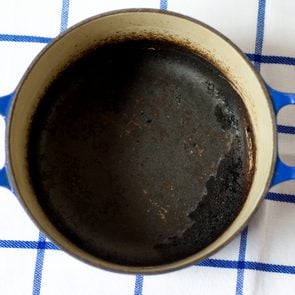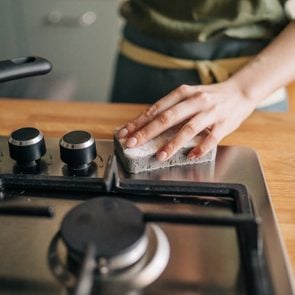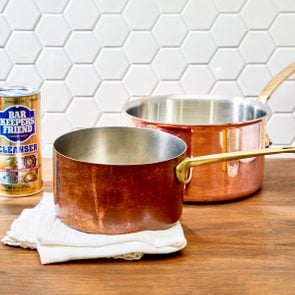How to Load a Dishwasher the Right Way
Updated: Apr. 18, 2024
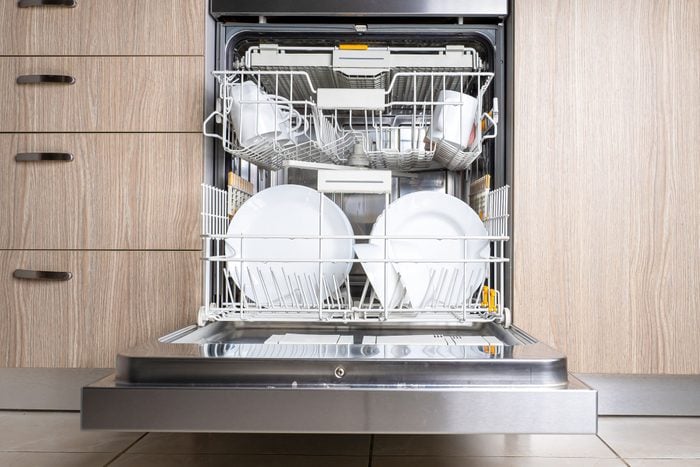
Think you know how to load a dishwasher? Our experts do. Here's how to make your dishes shine.
I’m not really particular about how to load a dishwasher, but I have a friend who’s the total opposite. While helping her clean up after dinner, I put a spoon in the dishwasher utensil basket. She turned it around. I added another one. Dang if she didn’t move that one too! I value this friendship, so I let her load the dishwasher while I wiped the table. After all, I do know how to clean that.
Today’s dishwashers are more sophisticated than ever, with high-tech soil sensors, water filtration and better drainage to maximize cleaning efficiency, according to Brandon Schaefer, the director of product management for dishwashers at GE Appliances who also spent years designing dishwashers. But, he says, “improper loading can leave you with dirty dishes after the cycle completes.” In other words, if your dishes aren’t getting clean, it’s probably your fault. (And mine, my friend would surely add.)
I apparently needed to learn how to load a dishwasher, stat. Besides this spoon thing, I started wondering what else had I been doing wrong this whole time. Apparently, a lot! Schaefer had tons of great tips to put me on the right path, as did an appliance-repair specialist and a cleaning pro. Ahead, find out what you might be doing wrong too—and how to load a dishwasher correctly.
Get Reader’s Digest’s Read Up newsletter for more cleaning, travel, tech, humor and fun facts all week long.
About the experts
Reviewed for accuracy by: Ann Russell, TikTok’s “cleaning auntie” and the author of How to Clean Everything. |
Does it really matter how you load a dishwasher?
Yes—and it’s not just to avoid arguments. When you load your dishwasher efficiently, “your dishes come out clean, and you make the most of the available space,” says Alicia Sokolowski, president and co-CEO of AspenClean, which offers housecleaning services and makes natural dishwashing detergents. Dishwashers work by circulating water and detergent around every item, so if you’re just stuffing things in willy-nilly, they won’t get clean. Who wants that? Not my friend, and honestly, not me either.
You can also ruin your dishes by loading your dishwasher the wrong way. If you tend to be a dish crammer like me, stop—like, right now. Mike Sperduto, a virtual appliance expert who helps people fix their dishwashers, says improper loading can leave you with broken items. Spacing dishes properly, and in the right rack, will prevent the water pressure and heat from chipping, breaking, melting and generally ruining your dishes, glassware and utensils.
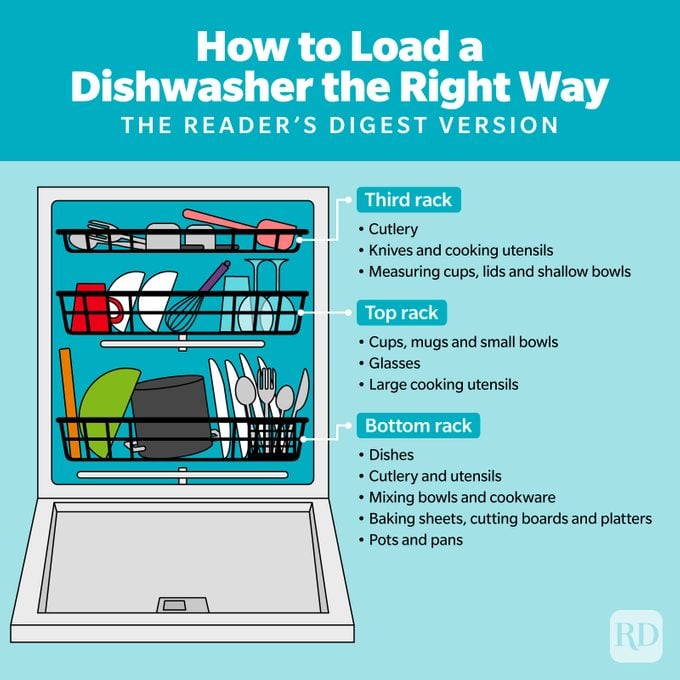
What to know before loading your dishwasher
Turns out, there’s not one exact way to load a dishwasher, but “there are many wrong ways to do it,” Schaefer says. Every dishwasher is different, so the first thing you should do is check your user manual. It will have detailed instructions and diagrams to help you get the best performance out of your particular dishwasher design.
But some things are universal, no matter which brand and model you have. Here’s what the pros say you should keep in mind.
1. Make sure items are dishwasher-safe
There are some things you should never put in the dishwasher—like dentures. My aunt ran her husband’s choppers through the dishwasher a few times, and for weeks, he couldn’t understand why everything tasted like bleach. True story.
So, some things you’re better off hand-washing. Those include (but are not limited to):
- Plastic that’s not marked dishwasher-safe
- Insulated coffee mugs and water bottles
- Wooden spoons, cutting boards, salad bowls and other wood items not labeled dishwasher-safe
- Cast iron, copper, aluminum or nonstick cookware
- Pressure-cooker lids and anything else that contains electronics, like immersion blenders
- Crystal stemware, although check to see if your dishwasher has a special cycle for delicate glassware
- Fine china and antique or family-heirloom dishes that you’re even slightly worried about
2. Make sure the spray arms can spin freely
Dishwashers use powerful jets to spray water and detergent from different angles, and blocking the spray arms prevents the dishwasher detergent from reaching all of the dishes. “Make sure that taller items on the bottom rack don’t block the spray arm, as this could hinder water circulation,” Sokolowski says. Also check that cookie sheets, long-handled pots and utensils that could slip below the racks can’t disrupt the cleaning action.
Give the spray arms a spin before starting the dishwasher, just to make sure there aren’t any blockers.
3. Point the dirtiest parts of dishes toward the center
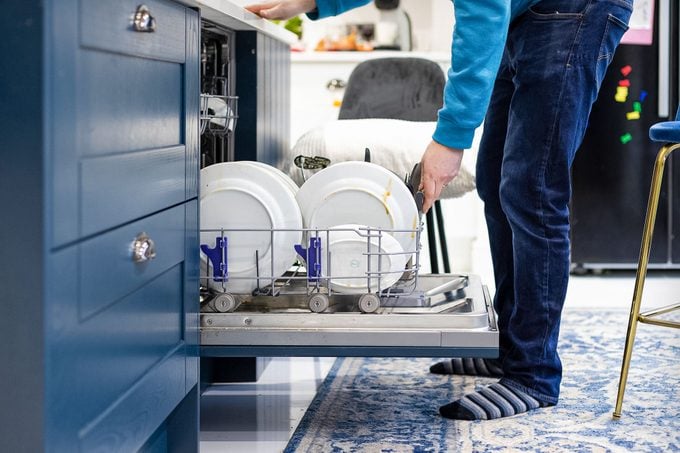
Most dishwasher arms spray water upward and outward from the center of the dishwasher, so whatever’s facing the center will get cleaned the best. That’s especially true for larger items that you’re stashing along the sides. If you face the dirty side of a cookie sheet against the side of the dishwasher, how will the water reach it? “Face larger items toward the center for better water circulation,” Sokolowski says.
4. Don’t obstruct the area in front of the detergent dispenser
Once, I loaded a cutting board along the front of the bottom rack, not realizing it blocked the detergent dispenser. The dishes came out dirty, and I had to run the load again. “Load larger items on the sides, corners or in the back,” Schaefer says. (Now you tell me!) Sokolowski says blocking the dispenser especially affects pods, which can’t release from the compartment. “Placing large items in front of the detergent dispenser can obstruct water flow and prevent the pod from dissolving properly,” she explains. Keep cutting boards, baking sheets and casserole dishes away from the door for better cleaning.
5. Scrape, don’t rinse, dishes
I confess: I used to scrape and rinse dishes before putting them into the dishwasher. Huge mistake. First of all, the detergent needs something to clean. “Dishwasher detergent and pods are designed to interact with food particles on dirty dishes,” Sperduto says. Say what now? “Pre-rinsing dishes can be counterproductive,” Sokolowski agrees, because dishwasher detergents use enzymes, not suds, to grab food particles and rinse them away. “They work more efficiently when there is some food soil present, as they are designed to target and react with these particles,” Sokolowski says.
There’s also wasted water to worry about. “If you are pre-rinsing, you’re most likely using more water in two minutes of rinsing those dishes than the dishwasher uses in the entire cycle,” Schaefer says. Really? Yep. Kitchen faucets manufactured since 1998 are required to have a flow rate of less than 2.2 gallons per minute (GPM), according to Energy.gov, and modern Energy Star–rated dishwashers use roughly 3 gallons (or less) for the entire cycle. Older, less-efficient models use more water, but it’s still nothing compared to running your sink while you load.
6. Don’t overcrowd racks
It’s tempting to try to cram dishes into every square inch of the dishwasher, but this is a bad idea. “The force of the water, combined with the detergent, helps to dislodge and remove food particles,” Sokolowski says. If water from the spray arm can’t reach a dish, it can’t clean it. Schaefer says bowls often end up the victim of this bad choice, because “people tend to overlap bowls” at the top, nesting them together slightly to save space. Sokolowski recommends leaving space between items to allow the water and detergent to reach all surfaces.
7. Add dish detergent and a rinse aid

Unless you’re using the dishwasher’s rinse-only cycle, add dishwasher detergent before starting the cycle—and only use detergent designed for automatic dishwashers. Pods can go where the regular detergent goes, but many models have a special compartment just for pods. Fill the cup to the line, or add the pod, and close the lid securely so it doesn’t pop open too early in the cycle. You can also add a little extra detergent in the “pre-wash” divot on the lid, but resist the urge to add more detergent than that, even with very dirty dishes. Just like laundry detergent, a little goes a long way.
Rinse aids aren’t strictly necessary, but they can be beneficial, especially if you have hard water. “Hard water can leave behind mineral deposits on dishes, making them look dull or spotted,” Sokolowski says. Rinse aids keep water from forming droplets that cling to your dishes and leave spots as they dry. They also shorten drying times. “By reducing surface tension, rinse aids allow water to drain more easily from dishes, resulting in faster drying times and more effective drying performance,” she says. Sokolowski recommends vinegar, citric acid and baking soda as alternatives to commercial options.
How to load a dishwasher
Enough with the basics. Let’s get to loading the dishwasher, rack by rack. But first, it bears repeating: “We recommend checking your use-and-care manual for guidance, especially if you are unsure if an item is dishwasher-safe or not,” Schaefer says. Owners manuals address the specifics of your dishwasher. Not all dishwashers have a third rack, for example, and the tines on the racks are configured differently from brand to brand. Silverware (aka utensil or cutlery) compartments also vary. Some have baskets, while others use individual slots for each fork, spoon and knife.
If you don’t have your user manual and can’t find it online, follow these tips from all three of our experts.
1. How to load a dishwasher’s bottom rack
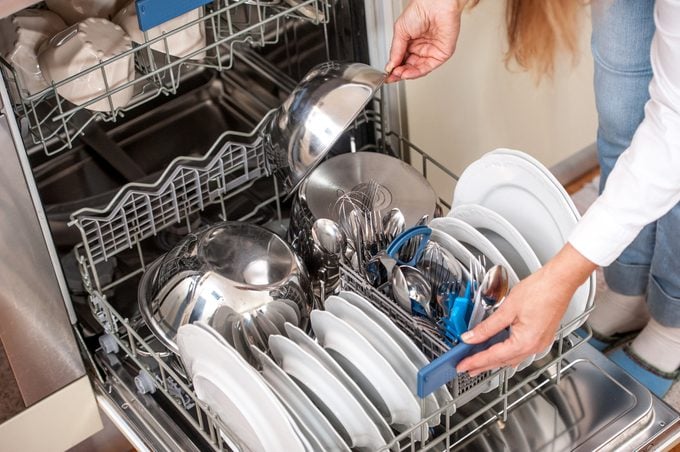
The bottom rack is for the big stuff: plates, larger bowls, casserole dishes, non-wooden cutting boards, dishwasher-safe pots and pans, serving platters and baking sheets. Utensil baskets are usually also on the bottom rack, but newer dishwashers sometimes move this to a third rack at the top of the dishwasher. “When loading the lower rack, think about the location of the detergent dispenser, spray arm and water jets,” Schaefer says. Make sure water can flow freely before closing it up.
Dishes
Load dishes individually between the tines, facing the center of the dishwasher and angled slightly downward toward the spray arms. This placement not only gives dishes the full blast from the spray arms, but it also aids in drying. Don’t put two dishes between the same tines. They’ll bang together, and they won’t get clean.
Cutlery and utensils
Handles up or down? “Ultimately, it’s really up to you,” Sokolowski says. Handles up is generally considered safer, especially for knives. Handles down gives utensils a deeper cleaning, according to Sokolowski, but you have to be careful when unloading. One thing you definitely need to do? “Mix up the placement to prevent nesting, ensuring water can reach each piece,” Sokolowski says. (My friend was right!)
Keep long utensils like serving spoons and spatulas out of the utensil basket; they can block the spray arm if they shift around. Also, while it’s OK to wash silver and silver-plated cutlery in the dishwasher, don’t wash them in the same load with stainless steel utensils. The two metals together cause a chemical reaction that will leave both damaged.
Mixing bowls and cookware
Load larger bowls, casserole dishes and bakeware face down, or on their side but angled down and toward the center, so they take the full force of the water and can drain without pooling water. Smaller bowls can go on their side, but again, angle them slightly downward and don’t nest them together. If your dishwasher’s tines are adjustable, move them around to use the space effectively, if needed.
Baking sheets, cutting boards and serving platters
Slide large, flat items like platters, cookie sheets and dishwasher-safe plastic or composite cutting boards along the back and sides of the bottom rack, with the dirty side facing inward. Don’t wash wooden cutting boards, which will eventually warp, and aluminum cookie sheets, which can discolor, in the dishwasher. Make sure the spray arm can spin when you’re done loading.
Pots and pans
Load dishwasher-safe pots and pans on the bottom rack, face down. “Heavily soiled pots and pans can benefit from being placed face down on the bottom rack,” so they get the full force of the jets and so they can drain, Sokolowski says. Pots and pans can also be loaded along the back and sides of the bottom rack. Just make sure they face the center of the dishwasher and are tilted downward to get the most spray.
2. How to load a dishwasher’s top rack
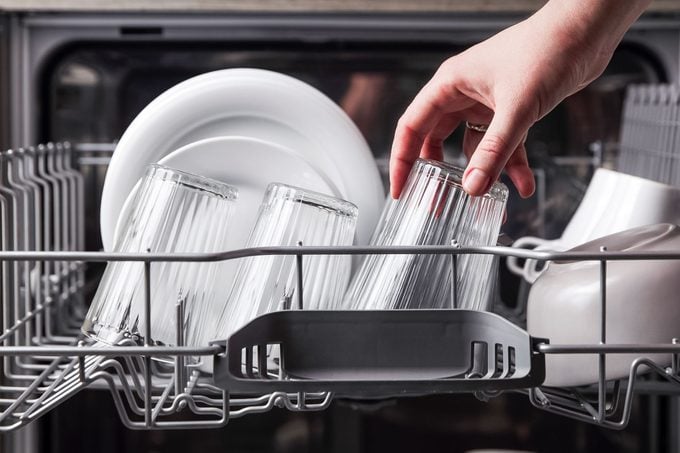
The top rack of your dishwasher is for cups, mugs, cereal bowls, small plates, dishwasher-safe plastic and cooking utensils. Many of these items aren’t suitable for the higher-pressure spray and temperatures of the bottom rack, especially plastic, which Sokolowski says can be “warped or damaged by the dishwasher’s heating element.” Other items, like cooking utensils, simply don’t fit anywhere else. You can even wash glass and stainless steel reusable water bottles up there, but for plastic water bottles, verify that they’re top-rack dishwasher-safe.
If your dishwasher has a third rack, the top rack is actually in the middle, and it can often be adjusted down to accommodate larger items.
Cups, mugs and small bowls, including dishwasher-safe plastic items
Place these items upside down, between the tines, aimed toward the center. Don’t rest them on the tines, Sokolowski says. It’s not a good use of space, and your lighter items, like plastic cups, are more likely to flip over and collect water if they’re dangling on the tines. Bowls and mugs placed along the outer edges of the rack should aim down and toward the center. Finally, don’t stack items on top of one another. They won’t get clean.
Glasses
Glasses generally go along the sides of the top rack. Look for the angled “rests” that hold your glassware with the open end pointing down and toward the center. Your dishwasher may also have special holders for wine glasses that flip up and hold the stem. Like cups, mugs and bowls, glassware goes between the tines, not over them.
Small plates and saucers
The center of the top rack is a good place for small plates and saucers. Slide them between the tines, tilted slightly downward and facing the center of the dishwasher. Don’t allow plates to nest together or share slots between the tines so water can freely circulate.
Large cooking utensils
Cooking and serving spoons, spatulas, whisks, tongs and other long or oddly shaped utensils should be laid flat on the top rack. Put large spoons and ladles face down so water won’t collect in them. And don’t leave big utensils in a jumbled pile. Like everything else in there, “be careful not to overlap or stack items so that water can spray between the dishes,” Schaefer says.
3. How to load a dishwasher’s third rack
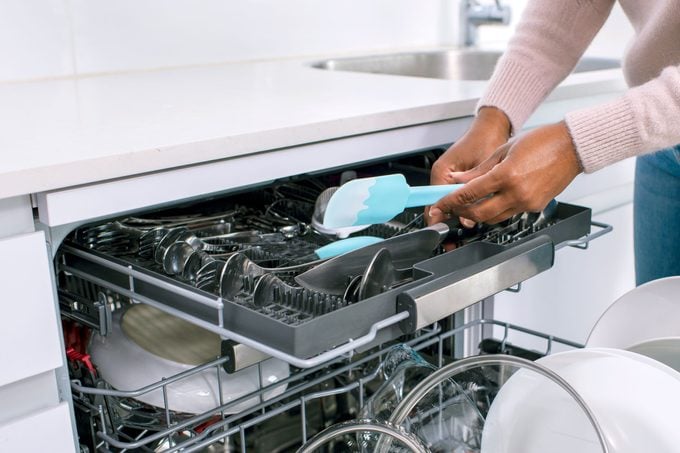
Third racks used to be limited to the best dishwashers, but Sperduto says you can now find them everywhere. Third racks, often called utensil trays, are thin, sliding upper racks that fit right against the top of the dishwasher. “This is the ideal space for utensils, flatware and cutlery,” according to Sperduto.
“It’s also good for knives, cooking and serving tools, commuter-mug lids or other small items,” Schaefer adds. Plus, third racks free up tons of space down below, which is great if you have a larger family or when you’re entertaining.
Cutlery
Some third racks are exclusively for silverware, and others have a section devoted to it. Either way, they generally have individual slots for your forks, spoons and knives. This takes a little longer to load, but the trade-off is the space saving. If you’re not sure how to load them, check your manual, but face down is always a good bet, Sperduto says.
Knives and cooking utensils
“If your dishwasher has a third rack, that is a great place for stacking knives,” Schaefer says. No, not on top of one another. Check to see if there are special slots, or lay them flat on the rack. (It’s still important not to impede water flow.) Place long spoons, spatulas, ladles and whisks up here too. Make sure to turn the ladle bowls downward so they don’t pool water, which will spill all over the rest of the dishes when you open the tray.
Measuring cups, lids and other shallow items
Schaefer says this is a great place for shallow items like those lids that go on your insulated travel mugs. (But not the mugs themselves, which should stay out of the dishwasher entirely.) Other things that can go up here include measuring cups (turned face down), ramekins and shallow bowls. Some larger-model dishwashers have a deeper third rack that looks more like a standard top rack, and you can use it to wash mugs and glasses alongside your silverware and utensils.
FAQs
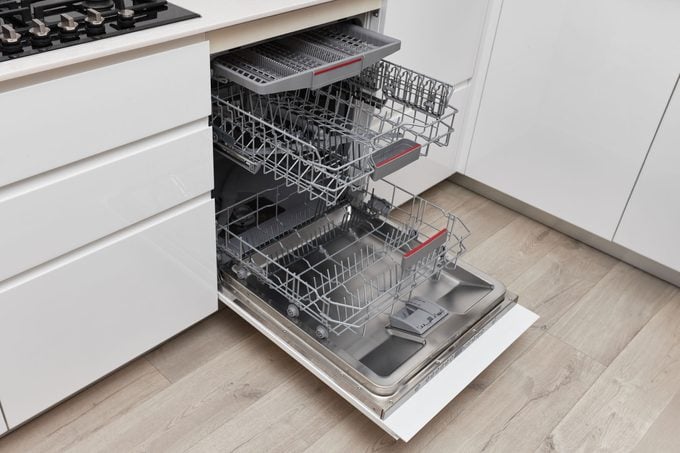
Can you put Tupperware on the bottom rack of a dishwasher?
It’s not a good idea. All three experts recommend keeping plastic items out of the bottom rack so they don’t melt or warp. Tupperware is sturdy and top-rack dishwasher-safe, but to keep it in the best shape, keep it off the bottom. Tupperware and other plastic food containers are also lighter than glass, metal and ceramic dishes, and the force of the water from the jets can flip them over, preventing them from getting clean.
What is the hottest part of a dishwasher?
Dishwashers get hot. We’re talking 150-degrees-or-more hot. “The heat helps to sanitize the dishes and aids in the removal of food residues,” Sokolowski says. The bottom of the dishwasher, nearest the heating element, is the hottest part. Keep plastics on the top rack, and make sure they’re dishwasher-safe. Often, this designation is stamped on the bottom of the plastic item or listed in paperwork or instructions that came with it; you can also check the company website.
How do I know if my dishwasher is overloaded?
Overloading the dishwasher can impact your wash results, according to Schaefer, and if your dishes remain dirty after running a cycle, that’s a big clue. Dirty dishes can be caused by other things, like facing them the wrong way or mechanical problems, but you may just have too many dishes in there. Look at your user guide, make sure you’re not nesting dishes or blocking the water jets and dispenser, and try again. If they’re still dirty, call a pro.
Additional reporting by Ally Childress.
Why trust us
At Reader’s Digest, we’re committed to producing high-quality content by writers with expertise and experience in their field in consultation with relevant, qualified experts. For this piece, Karen Gibbs tapped her extensive experience as a cleaning writer, and then Ann Russell, the author of How to Clean Everything and a TikTok cleaning expert with 2.5 million followers, gave it a rigorous review to ensure that all information is accurate and offers the best possible advice to readers. We verified all facts and data and backed them with credible sourcing, and we will revisit them over time to ensure they remain accurate and up to date. Read more about our team, our contributors and our editorial policies.
Sources:
- Brandon Schaefer, director of product management for dishwashers at GE Appliances; email interview, Feb. 23, 2024
- Mike Sperduto, virtual appliance expert at Frontdoor; email interview, Feb. 22, 2024
- Alicia Sokolowski, president and co-CEO of AspenClean; email interview, Feb. 8, 2024
- U.S. Department of Energy: “Best Practice: Kitchen Faucets”
- EnergyStar.gov: “Energy Star Certified Dishwashers”

